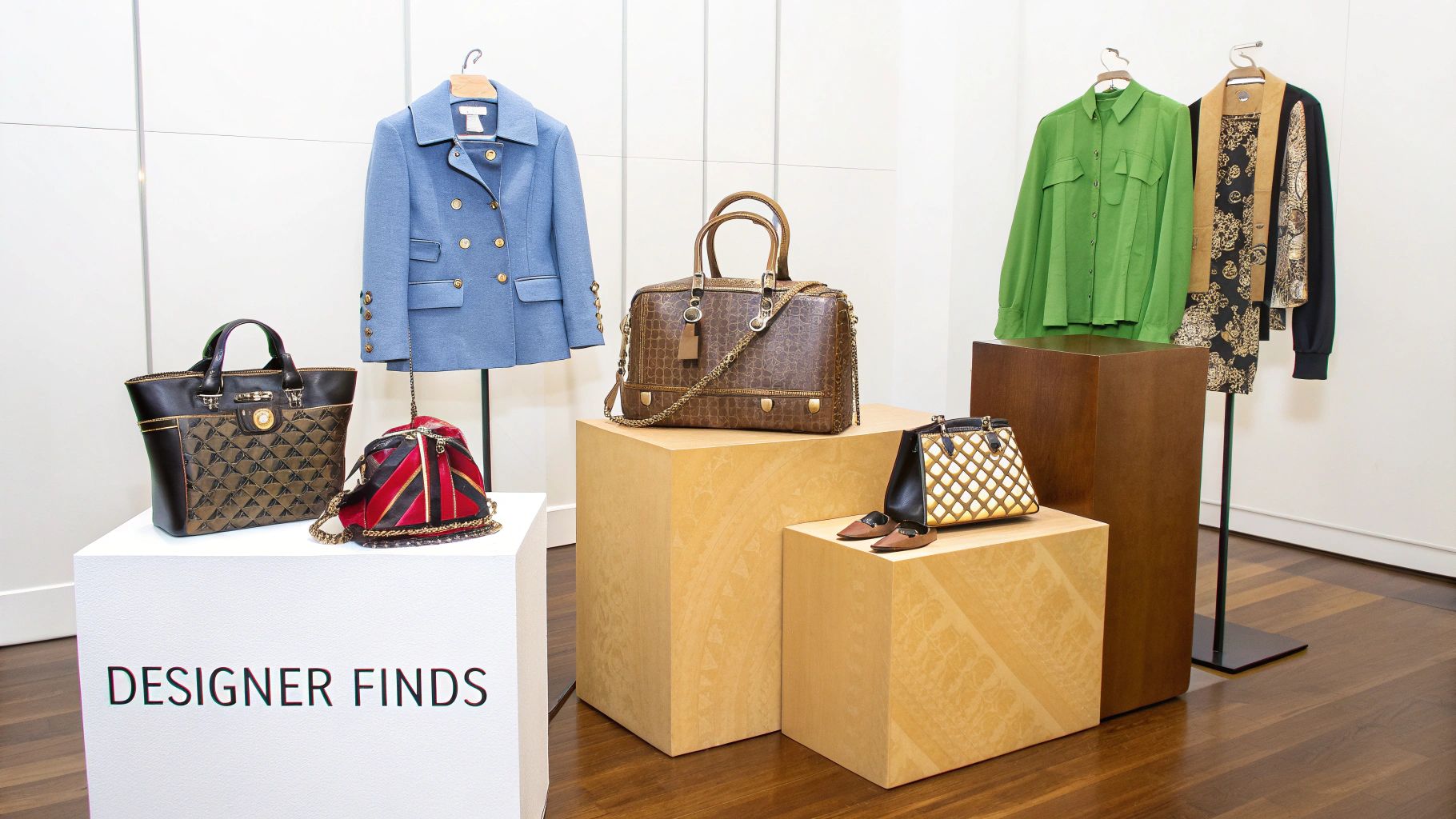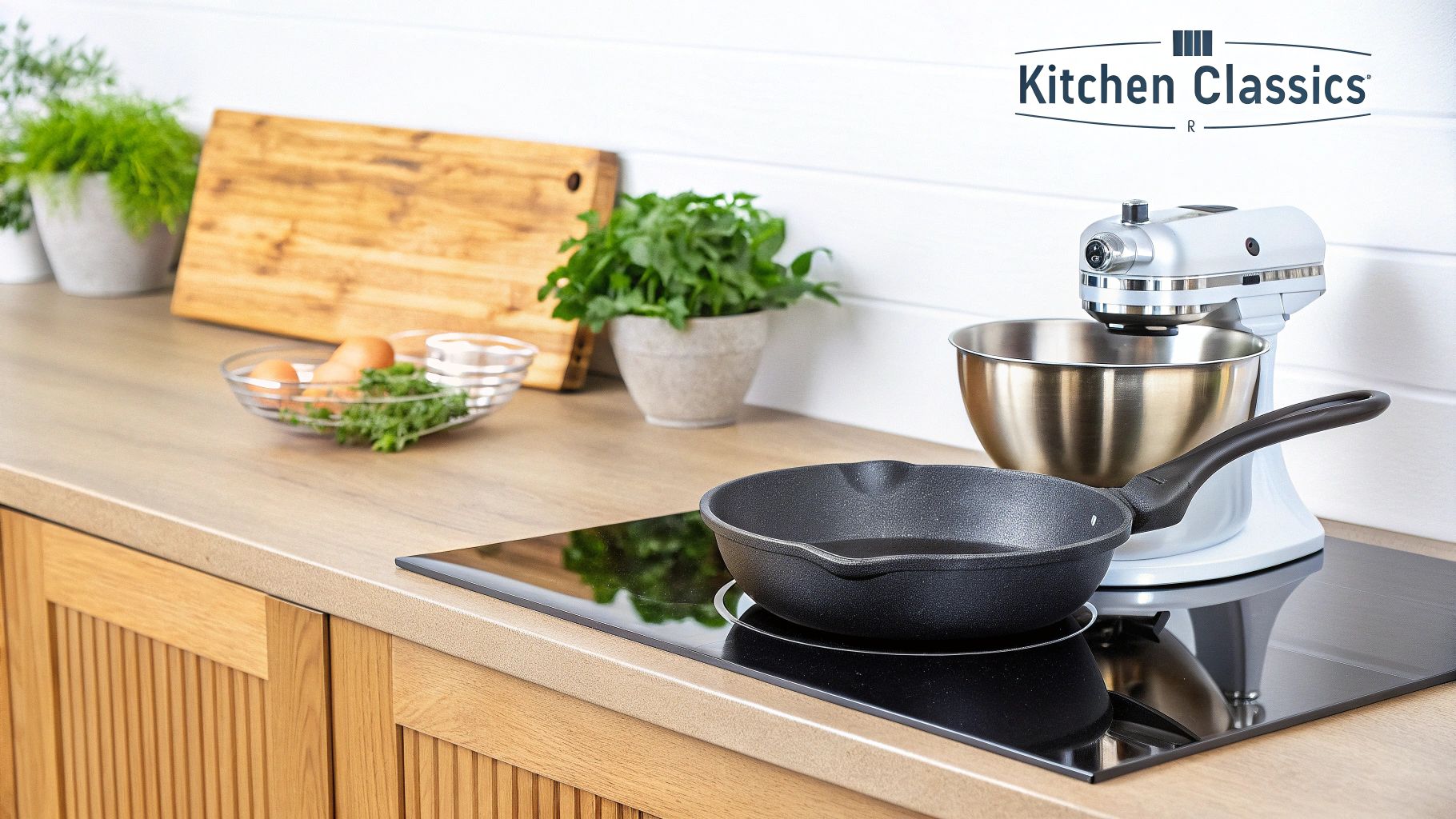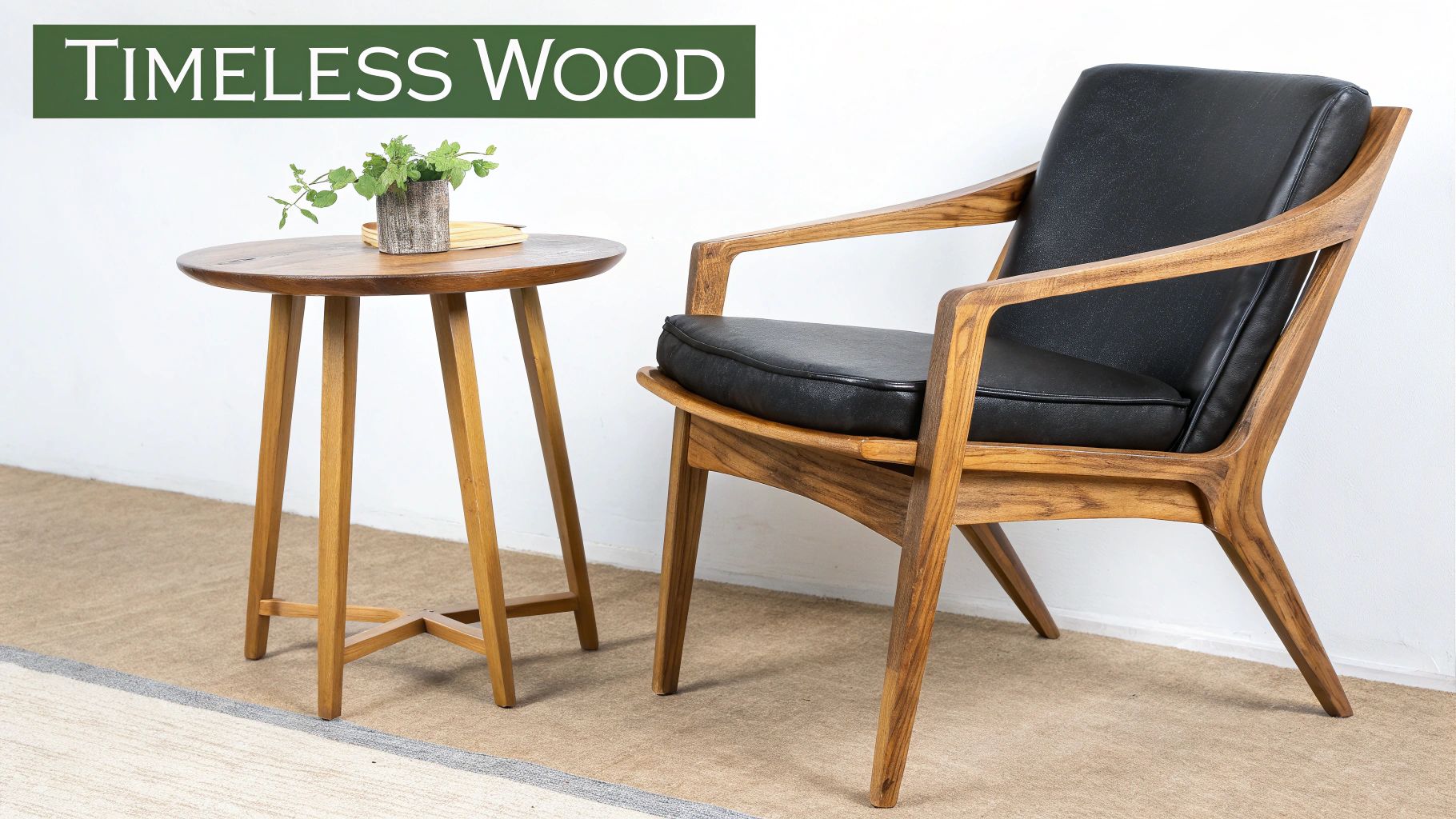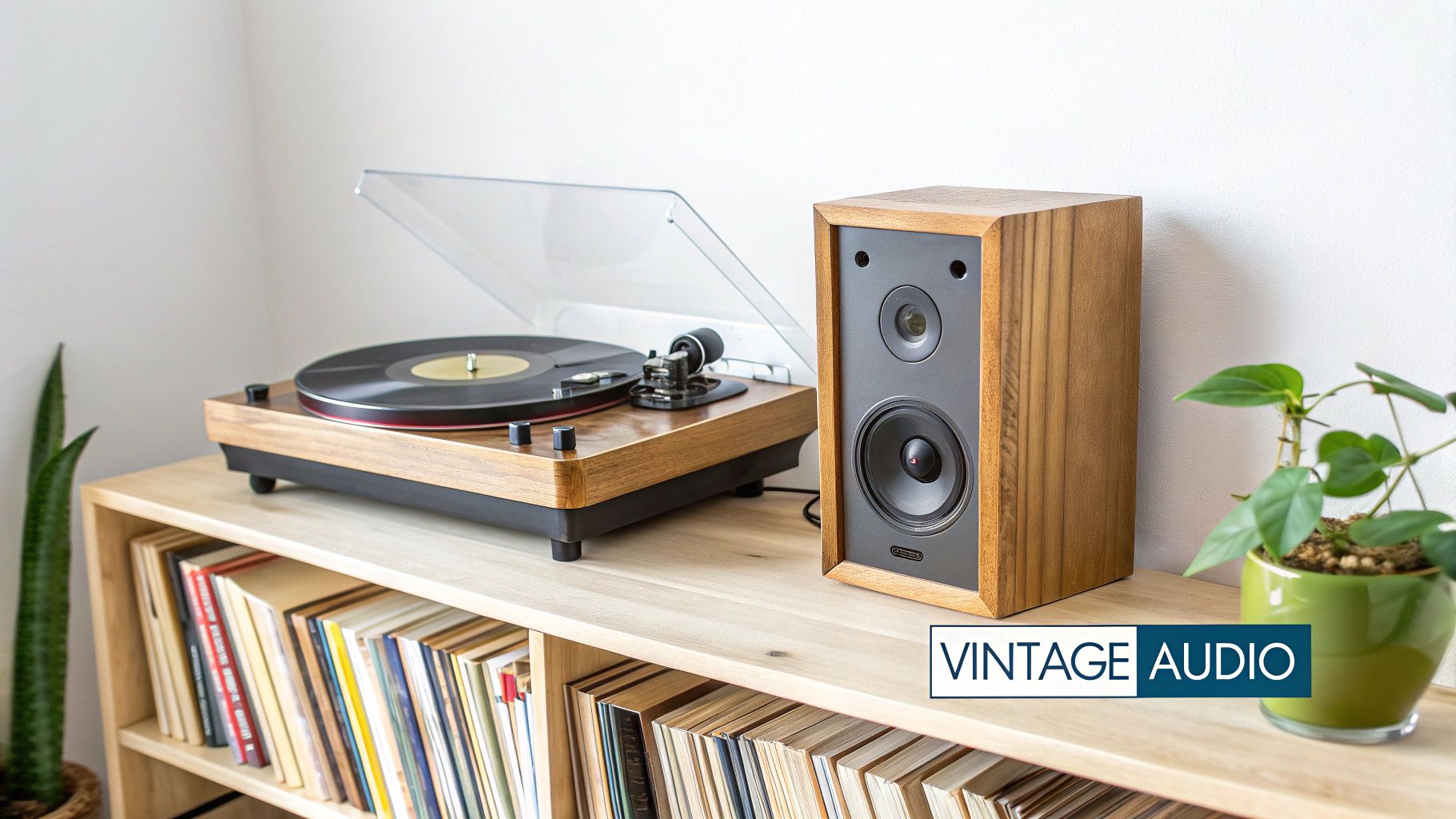Thrift stores are more than just secondhand shops; they are treasure troves of high-quality, unique, and valuable items waiting to be discovered. But navigating the aisles can feel overwhelming. How do you separate the junk from the gems? This guide reveals the best things to buy at thrift stores, providing expert tips on what to look for, how to identify quality, and why these items offer incredible value.
We'll explore 9 key categories where you can find durable, stylish, and often valuable pieces for a fraction of their original price. Learn how to spot real wood furniture, authenticate designer labels, and test vintage electronics. This article delivers actionable strategies, helping you recognize potential and avoid common pitfalls. By focusing on specific materials, brand identifiers, and signs of craftsmanship, you'll develop a keen eye for lasting quality.
And when you find something that sparks your curiosity, you'll want a tool to instantly understand its story. That’s where Curio comes in. Simply by taking a photo, Curio can help you identify an item's origin, history, and estimated market value, turning your thrifting hobby into an informed adventure. Let's begin your journey to becoming a savvy thrift shopper.
1. Vintage Designer Clothing and Accessories
Discovering high-end fashion is one of the most rewarding experiences when exploring the best things to buy at thrift stores. You can find luxury clothing, handbags, scarves, and other accessories from iconic brands for just a fraction of their original retail price. These finds are more than just stylish clothing; they are well-crafted pieces of fashion history that offer timeless appeal and incredible value.

Imagine finding a classic Chanel jacket for under $100 or an authentic Louis Vuitton Speedy bag mixed in with ordinary purses. Thrifters have reported finding Hermès silk scarves for as little as $20, which often retail for over $400. These aren't just myths; they happen every day in thrift stores across the country, especially in more affluent neighborhoods.
How to Spot Genuine Designer Pieces
Success in this category requires a sharp eye and a bit of knowledge. Here’s what to look for:
- Examine the Craftsmanship: Authentic designer items feature meticulous, even stitching. Check the seams, linings, and hems for any irregularities. The hardware, like zippers, clasps, and buttons, should feel heavy and substantial, often bearing the brand’s logo.
- Check the Labels and Markings: Familiarize yourself with the logos, fonts, and serial number formats of major brands. Counterfeits often have slight errors in spelling or design. For more in-depth guidance, you can learn how to identify vintage clothing and its tell-tale signs of authenticity.
- Feel the Materials: High-end brands use superior materials. Silk, cashmere, genuine leather, and high-quality wool have a distinct feel that sets them apart from cheaper synthetic fabrics.
Before you purchase a potential treasure, use the Curio app to quickly research the brand and specific item. A quick search can provide an estimated value and help you authenticate your find on the spot, ensuring your thrift store score is the real deal.
2. Quality Kitchen Appliances and Cookware
Outfitting your kitchen with professional-grade equipment is another excellent reason to explore the best things to buy at thrift stores. You can uncover durable, high-performance appliances and cookware from respected brands that are built to last a lifetime. Finding these items secondhand allows you to equip your kitchen like a professional chef without enduring the staggering retail costs.

It's common to find coveted items like a KitchenAid stand mixer for $30 to $80, a far cry from its $300+ retail price. Similarly, Le Creuset or Staub cast iron Dutch ovens can be spotted for $15 to $40, while they often sell for hundreds new. These workhorse items, from Cuisinart food processors to vintage Pyrex, retain their functionality and value, making them a savvy investment.
How to Spot Quality Kitchen Treasures
Securing reliable kitchen gear requires a bit of practical inspection. Here’s how to ensure your finds are functional:
- Test Electrical Components: Most thrift stores have an outlet where you can plug in appliances. Test all speeds and functions to ensure the motor runs smoothly and doesn't make any grinding or smoking noises.
- Check for Completeness: Look for all the essential parts. A food processor should have its blade, lid, and pusher. A stand mixer is most valuable with its bowl and at least one attachment like a whisk or paddle.
- Inspect for Damage: For cookware, check for deep scratches on non-stick surfaces, significant chips in enamel, or cracks in cast iron. A little rust on cast iron is often easily restorable, but structural damage is a deal-breaker.
- Research Model Numbers: A quick search of the model number on your phone can reveal the item's age, original features, and what accessories it came with.
Before you head to the checkout, use the Curio app to look up the brand and specific model. This can help you verify its market value and confirm you’ve found a genuinely high-quality piece worth adding to your culinary arsenal.
3. Solid Wood Furniture
Finding solid wood furniture is another top-tier discovery when searching for the best things to buy at thrift stores. Unlike modern, mass-produced items made from particleboard or MDF, vintage and antique furniture was built to last for generations. You can uncover everything from sleek mid-century modern sideboards to sturdy antique oak dressers, often for less than the cost of a new, poorly made equivalent. These pieces offer unparalleled durability, character, and the potential for a stunning transformation.

It’s not uncommon to find a solid teak Danish armchair for under $50 or a beautifully crafted mahogany desk that just needs a little polish. These finds are especially prevalent in thrift stores that receive donations from estate clear-outs. A little bit of love and restoration can turn a forgotten piece into a valuable and functional centerpiece for your home, adding a story and craftsmanship that new furniture simply cannot match.
How to Spot Quality Wooden Furniture
Identifying a quality piece requires a hands-on approach and a keen eye. Here’s what to inspect before you buy:
- Check the Joints and Construction: Quality furniture often features dovetail, mortise-and-tenon, or dowel joints rather than just glue, nails, or staples. Gently wiggle the piece to test its sturdiness; a wobbly frame can indicate serious structural issues that are difficult to fix.
- Look for Maker's Marks: Turn the piece over and check inside drawers for labels, stamps, or burn marks from the manufacturer. Brands like Drexel, Lane, and Ethan Allen are common thrift store finds and signify good construction. Our guide can help you learn how to identify vintage furniture and its makers.
- Assess the Material and Condition: Look for the tell-tale grain patterns of real wood. Lift a corner if you can; solid wood is significantly heavier than particleboard. Check for any signs of woodworm holes or serious water damage that might compromise the piece.
Before committing, use the Curio app to research the maker's mark or style of the furniture. This can help you understand its potential value and history, ensuring your thrifted find is a solid investment in both style and quality.
4. Vintage Electronics and Audio Equipment
For audiophiles, gamers, and tech enthusiasts, the electronics section of a thrift store can be a treasure trove. Vintage electronics and audio equipment often boast superior build quality and a unique analog warmth that modern devices struggle to replicate. Finding these items is a major win, as they represent some of the best things to buy at thrift stores for both personal use and high resale value.

Imagine uncovering a classic Technics turntable for under $50 or finding a vintage Marshall amplifier capable of producing legendary rock tones. Collectors regularly find high-end speakers from brands like JBL or Klipsch and retro gaming consoles like the Nintendo 64, complete with games. These pieces aren't just nostalgic; they are functional items prized for their performance and durability.
How to Find Quality Vintage Electronics
Patience and a keen eye are essential for separating valuable finds from outdated junk. Here’s how to identify promising equipment:
- Test Functionality: Most thrift stores have an area where you can plug in and test electronics. Always check if the item powers on. For audio gear, listen for crackling sounds when turning knobs, which could indicate dirty potentiometers, a common and often fixable issue.
- Research Brands and Models: Familiarize yourself with reputable vintage brands. In audio, look for names like Marantz, Pioneer, Sansui, and Technics. For gaming, Nintendo, Sega, and early PlayStation consoles are always in demand. A quick search can reveal if a model is sought after.
- Inspect for Physical Damage: Check for cracks in the casing, significant rust, or water damage. Examine cables for fraying or damage. While minor cosmetic scuffs are expected, major structural issues could mean the item is beyond simple repair.
Before you commit, use the Curio app to research the specific model you've found. You can get an estimated market value and check for common issues or restoration tips, helping you decide if your electronic discovery is a sound investment.
5. Books and Literature
The book section is often a treasure trove and one of the best things to buy at thrift stores. You can find everything from timeless classics and out-of-print novels to niche academic texts and stunning coffee table books, all for pennies on the dollar compared to their original price. These finds are more than just reading material; they can be collectible artifacts, valuable resources, or simply a way to build a personal library on a budget.
Imagine discovering a first edition of a beloved classic novel tucked away on a dusty shelf or a vintage cookbook full of forgotten family recipes. Thrifters often report finding signed copies from local authors, beautiful art and photography books perfect for display, and even rare academic texts that are no longer in print. These discoveries happen frequently, turning a simple browse into an exciting literary hunt.
How to Spot Valuable Books
Finding a valuable book requires more than just checking the cover. Here’s what to look for to identify a worthwhile find:
- Check the Copyright Page: This is the most important page for collectors. Look for the words "First Edition" or "First Printing." A number line that includes a "1" (e.g., 10 9 8 7 6 5 4 3 2 1) often indicates a first printing.
- Inspect the Condition: A book's value is heavily tied to its condition. Check for a tight spine, clean pages free of writing or stains, and an intact dust jacket. Minor wear is acceptable, but significant damage can drastically lower its value.
- Look for Special Features: Keep an eye out for an author's signature on the title page, as signed copies are almost always more valuable. Limited print runs, special publisher's bindings, and unique illustrations can also increase a book's worth.
Before you check out, use the Curio app to quickly search the title, author, and edition details. This can help you determine its market value and confirm if you’ve stumbled upon a rare gem or just a great read, making sure your literary find is a true score.
6. Artwork and Decorative Items
Finding original artwork and unique decorative items is another one of the best things to buy at thrift stores, allowing you to infuse your home with personality and style. You can discover original paintings, limited-edition prints, handcrafted sculptures, and other decorative pieces that add character and may hold significant value. These finds go beyond mass-produced decor; they are unique expressions of creativity that can become cherished focal points in any room.
Imagine discovering an original painting by a known regional artist tucked behind a stack of generic prints or finding a piece of mid-century modern ceramic pottery for a few dollars. Thrifters have reported finding signed prints from famous artists and unique handcrafted sculptures that were later appraised for hundreds, or even thousands, of dollars. These discoveries happen frequently, especially in stores that receive donations from art-loving communities or estate clear-outs.
How to Spot Valuable Art and Decor
Success in this area requires a keen eye for aesthetics and some basic research skills. Here’s what to look for:
- Look for Signatures and Markings: Examine paintings and prints for an artist's signature, often in a corner. For ceramics, sculptures, and glass, check the bottom for a maker's mark, stamp, or signature. These are crucial clues for identifying the artist or studio.
- Assess the Quality of Materials: Genuine artwork is often created on quality canvas, art board, or high-grade paper. Look for quality framing, as custom frames often indicate the original owner valued the piece. For decorative objects, feel the weight and finish; well-made ceramics and sculptures feel substantial.
- Trust Your Instincts (and Do Your Research): While you should buy what you love, don't ignore pieces that simply look interesting or well-made. A quick search for the artist's name or maker's mark can reveal their significance and potential market value. Consider restoration costs if a piece is damaged but seems promising.
When you find a piece of art that catches your eye, use the Curio app to quickly research the artist’s signature or markings. This can help you determine if you've found a hidden gem from a listed artist, ensuring your thrift store find is both a beautiful and valuable addition to your collection.
7. Quality Leather Goods
Hunting for quality leather goods is a rewarding pursuit and one of the best things to buy at thrift stores. You can uncover well-made leather bags, jackets, shoes, and accessories that offer superior durability and timeless style. Unlike their fast-fashion counterparts, genuine leather items improve with age, developing a unique patina that tells a story and can last for decades with proper care.
Imagine discovering a vintage Coach briefcase for $25 or a high-quality leather jacket from a premium brand for a fraction of its original price. Thrifters often find handcrafted leather boots, designer handbags, and sturdy satchels from renowned makers that simply need a good conditioning. These pieces represent incredible value, offering craftsmanship that is often too expensive when purchased new.
How to Spot Genuine Quality Leather
Identifying high-quality leather requires paying attention to the details. Here’s what to look for to ensure you’re getting a durable, authentic piece:
- Check the Leather Quality and Type: Genuine leather has a distinct, slightly imperfect texture and a rich smell. Look for full-grain or top-grain leather, which are the most durable types. Avoid bonded leather, which is made from scraps and will peel over time.
- Inspect Stitching and Hardware: Quality craftsmanship is evident in the details. The stitching should be thick, even, and tight, with no loose threads. Zippers, buckles, and clasps should feel heavy and solid, a sign of durable hardware that won't easily break.
- Look for Maker's Marks: Many high-quality leather goods feature a maker's mark or brand stamp, indicating its origin and craftsmanship. Even if the brand isn't famous, a clear mark often signals a piece made with pride and care.
Before you commit, remember to factor in potential restoration costs, like professional cleaning or conditioning. You can use the Curio app to quickly research the brand or maker's mark you find. This can help you determine the item’s potential value and confirm you’ve found a genuine leather treasure worth investing in.
8. Vintage Sporting Goods and Equipment
Thrift stores can be a goldmine for classic sports equipment and outdoor gear, offering another category of the best things to buy at thrift stores. You can find everything from vintage golf clubs and antique fishing reels to classic camping gear and retro bicycles. These older items often feature superior construction and materials compared to their modern, mass-produced counterparts, delivering both high performance and a unique, timeless aesthetic.
Imagine uncovering a set of vintage Ping golf clubs known for their exceptional feel, or a classic Coleman lantern that just needs a little polish to light up your next camping trip. Thrifters often find high-quality leather baseball gloves that are already perfectly broken in or sturdy, well-made vintage bicycles from brands like Schwinn or Raleigh. These finds are not just functional; they represent a legacy of quality craftsmanship.
How to Spot Quality Sporting Goods
Identifying valuable vintage sporting gear requires an eye for durability and brand heritage. Here’s what to look for:
- Inspect for Structural Integrity: Carefully check for cracks, rust, or significant wear, especially on items that need to be safe, like bicycles or camping equipment. Test moving parts like gears, reels, and hinges to ensure they still function correctly.
- Research Vintage Brands: Familiarize yourself with renowned sporting goods manufacturers from different eras. Brands like Wilson, Rawlings, Penn, and Abu Garcia have a long history of producing quality equipment. Look for older logos and branding.
- Consider Restoration Potential: Many vintage items may need minor repairs or cleaning. Assess the cost and availability of replacement parts. Sometimes, a little bit of work can restore an item to its former glory and significantly increase its value.
Before you commit, a quick search on the Curio app can help you identify the specific model and its market value. This ensures you’re not just buying an old piece of equipment but a genuine classic that holds its worth.
9. Collectibles and Memorabilia
Thrift stores are veritable treasure troves for collectibles and memorabilia, making them one of the best things to buy at thrift stores for hobbyists and investors alike. You can find items with significant collectible value, including vintage toys, coins, stamps, and pop culture merchandise. These pieces not only provide a sense of nostalgia but can also appreciate in value over time, turning a simple purchase into a profitable find.
Imagine uncovering a box of 1980s Star Wars figures or a stack of first-edition comic books tucked away on a dusty shelf. Many thrifters have discovered valuable sports cards, rare stamps, or vintage Barbie dolls still in their original packaging. These finds are often donated by individuals unaware of their market value, creating incredible opportunities for collectors who know what to look for.
How to Spot Valuable Collectibles
Identifying a valuable collectible requires a keen eye and specialized knowledge. Here’s what to focus on:
- Check for Markings and Edition: Look for manufacturer marks, dates, or edition numbers. A "first edition" comic book or a "Made in Japan" mark on a vintage toy can significantly increase its value. Limited edition items are often more desirable.
- Assess the Condition: Condition is paramount. For items like trading cards, comic books, and toys, mint or near-mint condition commands the highest prices. Check for fading, tears, creases, or missing parts, as these flaws can dramatically reduce value.
- Identify Authenticity: Reproductions are common, especially with popular memorabilia. Learn to spot the signs of an original, such as specific material types, printing techniques, or unique wear patterns that differ from modern fakes.
Once you find a potential collectible, use the Curio app to quickly research its market value and historical sales data. This ensures you know what you have before you buy. After you bring your treasures home, find inspiration with these creative collectible display ideas to showcase your unique finds.
Top 9 Thrift Store Finds Comparison
| Item | Implementation Complexity 🔄 | Resource Requirements ⚡ | Expected Outcomes 📊 | Ideal Use Cases 💡 | Key Advantages ⭐ |
|---|---|---|---|---|---|
| Vintage Designer Clothing and Accessories | High: requires authentication skills and time-intensive searching | Moderate: needs knowledge and patience | High: access to rare, high-quality pieces, potential investment | Fashion enthusiasts seeking luxury on a budget, sustainable fashion | Significant savings, unique styles, superior quality |
| Quality Kitchen Appliances and Cookware | Medium: testing and inspecting equipment needed | Moderate: requires testing, some mechanical knowledge | High: durable, professional-grade kitchen tools | Home cooks, chefs looking for quality gear affordably | Cost savings, access to discontinued models, eco-friendly |
| Solid Wood Furniture | Medium-high: requires inspection and possibly restoration | High: physical effort for transport and possible refinishing | High: durable, timeless furniture with value retention | Furniture collectors, DIY renovators, sustainability advocates | Superior durability, restoration potential, unique character |
| Vintage Electronics and Audio Equipment | High: technical knowledge needed for testing and repair | Moderate: requires testing and possible servicing | Medium-high: superior analog sound, collectible value | Audiophiles, retro gamers, musicians seeking vintage tone | Superior sound quality, repairable, collectible potential |
| Books and Literature | Low: mostly selection and condition checking | Low: minimal effort except storage | Medium: access to rare, affordable, and educational materials | Readers, collectors, educators | Affordable, rare titles, supports recycling |
| Artwork and Decorative Items | Medium-high: expertise needed to assess authenticity and condition | Moderate: research and careful selection | Medium-high: unique decor, potential value appreciation | Art collectors, interior designers, antique enthusiasts | Unique pieces, collectible value, cultural support |
| Quality Leather Goods | Medium: requires inspection of leather quality and condition | Moderate: knowing care and restoration needs | High: durable, long-lasting items that age well | Fashion enthusiasts, quality-focused consumers | Exceptional durability, attractive patina, restoration potential |
| Vintage Sporting Goods and Equipment | Medium: needs inspection for safety and condition | Moderate: research and possible maintenance | Medium-high: durable gear with unique designs | Collectors, outdoor enthusiasts, athletes | Superior build quality, affordable premium items |
| Collectibles and Memorabilia | High: specialized knowledge for value and authenticity | Low to Moderate: mostly research and storage | High: potential significant investment returns | Collectors, hobbyists, pop culture fans | High return potential, nostalgia, educational value |
Transform Your Finds from Mystery to Masterpiece
Thrifting is far more than a simple shopping trip; it's a treasure hunt fueled by patience, observation, and a keen eye for potential. As we've explored, the aisles of second-hand stores are brimming with opportunities to acquire items of incredible quality, history, and value. By focusing your efforts on the nine key categories we've detailed, you transform your approach from aimless browsing to strategic hunting. You're no longer just looking for a bargain; you're searching for enduring quality that modern retail often fails to deliver.
The best things to buy at thrift stores aren't just objects; they are gateways to the past and investments in your future. A piece of solid wood furniture can become a family heirloom, a vintage cast iron skillet can serve generations of cooks, and a first-edition book can connect you directly to literary history. Each item, from a well-made leather satchel to a piece of forgotten artwork, carries a story waiting to be rediscovered and appreciated.
Your Blueprint for Thrifting Success
To truly master the art of the find, remember these core principles:
- Shop with a Plan: Know what you’re looking for. Keeping a running list of desired items, materials (like solid wood, leather, or cast iron), and brands will help you cut through the clutter and spot value quickly.
- Inspect with Intent: Quality is in the details. Check for maker's marks, examine the construction, test the zippers, and look for signs of authentic wear versus irreparable damage. A few extra seconds of inspection can save you from a bad purchase.
- Trust Your Instincts (and Your Tools): If an item feels special, it probably is. But don't rely on gut feelings alone. This is where modern technology becomes your secret weapon. An item's true story and value are often hidden just beneath the surface.
Key Takeaway: The difference between a casual thrifter and a seasoned expert is the ability to recognize latent value. It’s about seeing a scuffed-up table not as damaged goods, but as a solid oak piece that just needs a little sanding and care to shine again.
Embracing this mindset elevates thrifting from a hobby into a rewarding skill. You save money, champion sustainability by giving items a second life, and curate a home and wardrobe filled with unique, high-quality pieces that reflect your personal style. The thrill of discovering something truly special, an object that has stood the test of time, is a reward in itself. So, enter every thrift store with this guide in mind, prepared to look deeper. The greatest treasures are often waiting right there, hiding in plain sight for the discerning eye to find them.
Ready to uncover the history and value of your next great find? Download Curio to get instant identification, historical context, and valuation for your thrifted treasures right from your phone. Turn curiosity into confidence and ensure you never pass up a masterpiece again. Learn more and get the app at Curio.
